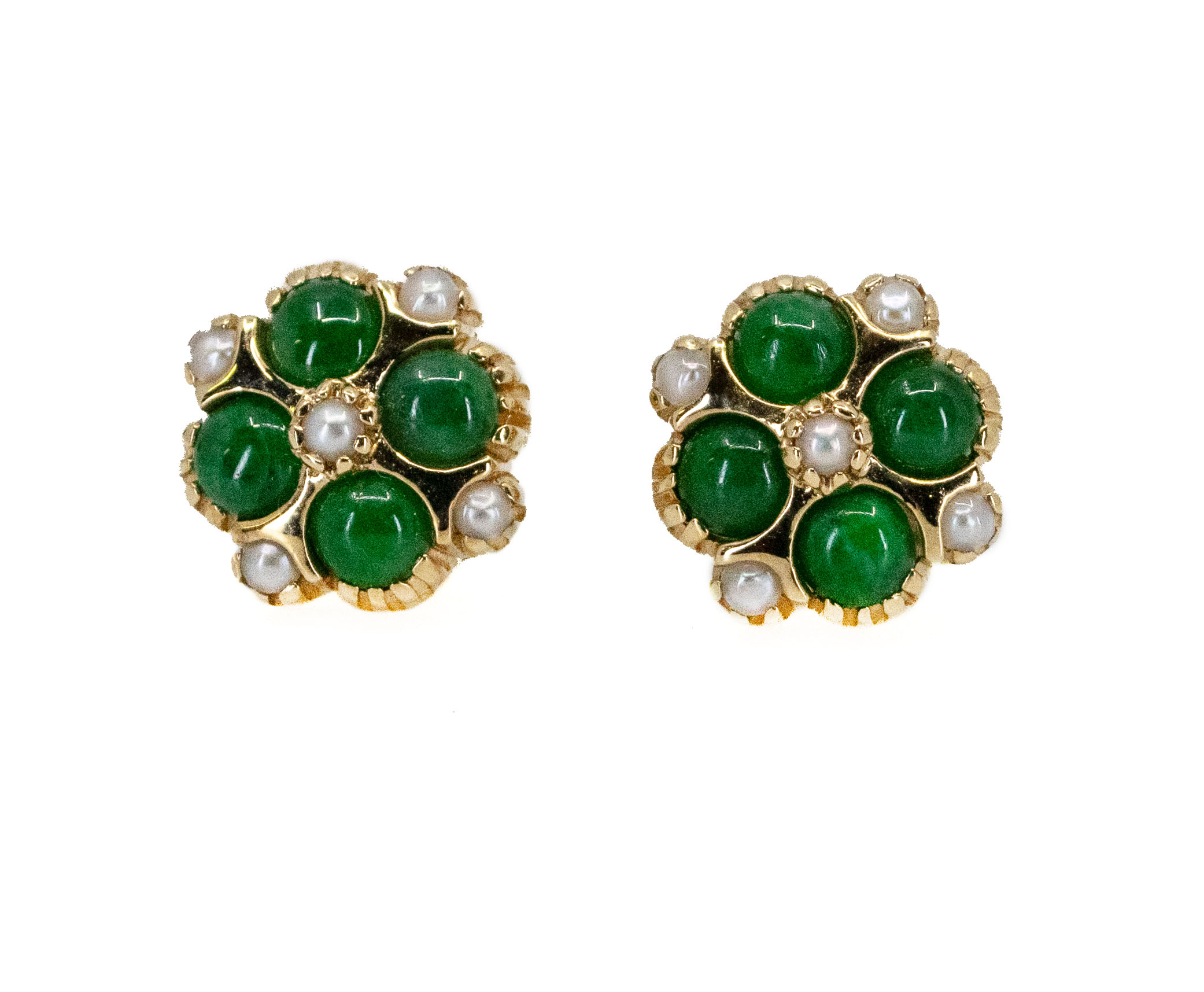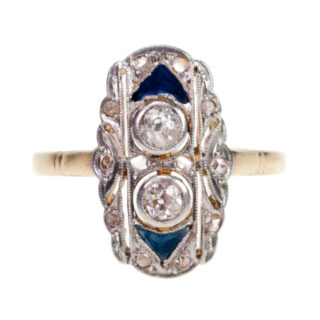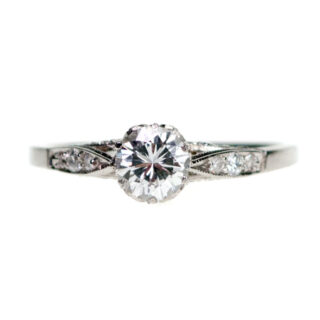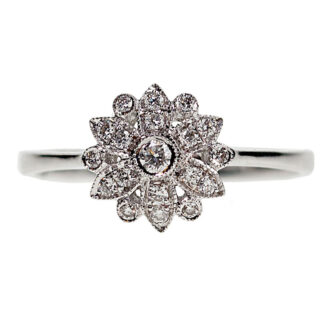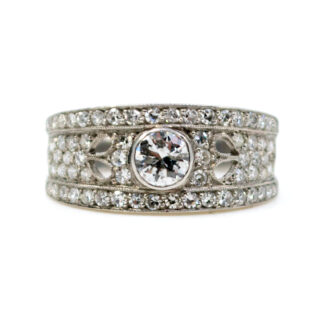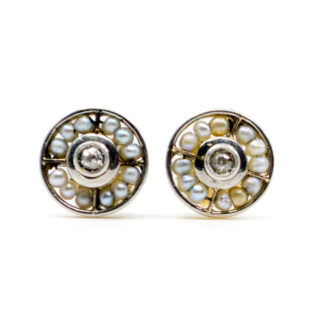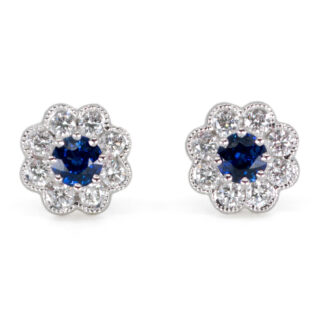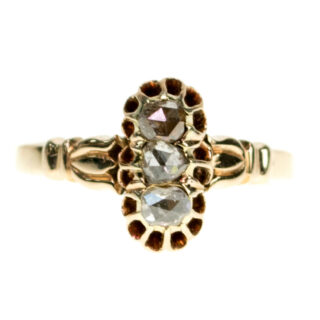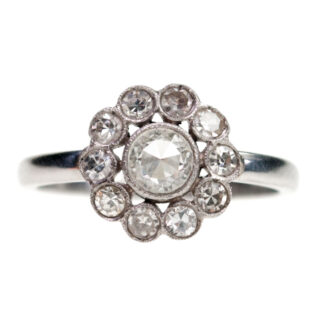These beautiful Victorian-style earrings are made from 14k gold and feature a flower design. Each earring has four jades that are decorated with five pearls.
Details: Jades, Pearls, 14k Earrings.
Design Era: New Victorian.
Dimensions: 0.9 cm.
Weight in grams: 2,3 .
Condition: New.
Shipping and Pickup: This beautiful piece ships from our store located in the center of Amsterdam, The Netherlands. We offer both registered shipping and local pickup at our store. In the case of local pickup, any applicable shipping costs will be refunded.
About Us: Add some sparkle to your style with Binenbaum.com. We offer a stunning selection of antique and vintage jewelry that you won’t find anywhere else. From timeless rings and dazzling necklaces to unique brooches, we have something for every taste and occasion. Visit our website today and treat yourself to a piece of history.
| Design Era | |
|---|---|
| Design & Historical Context | The Victorian Era spanned Queen Victoria's rule of England from 1837 until 1901. During this time, a middle class began to emerge, sparking a demand for jewelry in the mass market, jewelry trends often reflected the tone of current events. The era is usually divided into several subsections: the Romantic Period from 1837 to 1861, the Grand Period from 1861 to 1880, and the Aesthetic Period from 1880 to 1901. During the Romantic Period jewelry also featured nature-inspired designs, similar to jewelry of the Georgian era. Frequently, these designs were delicately and intricately etched into gold. Lockets and brooches were popular in daytime jewelry during the early Victorian era, whereas colored gemstones and diamonds were worn during the evening. During the Grand Period jewelry , because the Grand or Mid-Victorian era corresponded with the death of Queen Victoria's husband, many jewelry pieces have solemn, somber designs. Known as mourning jewelry, the pieces feature heavy, dark stones. Jet, onyx, amethyst, and garnet are frequently found in jewelry from this period. Compared to previous periods, Mid-Victorian-era jewelry features highly creative, colorful designs using shells, mosaics and gemstones. During the Aesthetic period, jewelers used diamonds and feminine, bright gemstones such as sapphire, peridot, and spinel. Star and crescent designs as well as elaborate hat pins were also popular. Some scholars believe the aesthetic era began sooner, in 1875, and ended as early as 1890. |
| Key Materials | |
| Materials & Craftsmanship | Jade Jade is a type of metamorphic rock that is formed from the metamorphism of rocks such as marble, serpentinite, and basalt. It is a dense and hard stone that is composed mainly of the minerals jadeite and nephrite. It is most commonly associated with the color green, but it can also be found in shades of white, black, red, yellow, and lavender. Jade has been used for centuries in a variety of different cultures and has been prized for its beauty and its perceived spiritual and healing properties. In Asian cultures, jade is often associated with good luck and prosperity, and it is believed to have the ability to protect the wearer from harm. It is also thought to have calming and grounding properties, and is sometimes used in meditation practices. Jade is used in a variety of different ways, including in jewelry, sculpture, and decorative objects. It is also used in traditional Chinese medicine, where it is believed to have various healing properties. Despite its popularity, jade is a relatively rare stone and is often quite expensive. Pearl Pearls are small, round, and lustrous objects that are produced by certain types of mollusks, which are invertebrate animals that belong to the phylum Mollusca. Mollusks include a wide range of species, including oysters, clams, mussels, snails, and octopuses, among others. While all mollusks have the ability to produce pearls, only a few varieties are able to create gem-quality pearls that are suitable for use in jewelry. These include the oysters that produce akoya pearls, the freshwater mussels that produce freshwater pearls, and the South Sea and Tahitian pearls, which are produced by large saltwater oysters. Pearls are formed when an irritant, such as a grain of sand or a parasite, enters the mollusk and becomes trapped inside its shell. In response to the irritant, the mollusk secretes a substance called nacre, which coats the irritant and eventually forms a pearl. The quality of a pearl is determined by a number of factors, including its size, shape, color, and luster. High-quality pearls are prized for their beauty and are used in a variety of different types of jewelry, including necklaces, earrings, and bracelets. 14k 14k gold is a popular choice for use in jewelry because it is durable, yet still relatively affordable compared to higher karat golds like 18k or 24k. It is made up of 58.5% pure gold and is mixed with other metals to make it harder and more durable. 14k gold is available in a range of colors, including yellow, white, and rose, and is commonly used in a variety of jewelry pieces such as rings, earrings, necklaces, and bracelets. One of the advantages of 14k gold is that it is more resistant to wear and tear than pure gold, which makes it suitable for everyday wear. However, it is still softer than other alloys such as stainless steel or platinum, so it may require more maintenance to keep it looking its best. Overall, 14k gold is a popular choice for those who want the look and feel of gold, but at a more affordable price point. |
| Dimensions | 0.9 cm |
| Gender | |
| Weight (in grams) | 2,3 |
| Condition |
Enhance the Beauty of Your Jewelry with Proper Care
Wearing your jewelry is a special way to express yourself and add a touch of personal style to any look. However, to ensure your jewelry remains in pristine condition, there are a few simple steps you need to take to keep it looking its best.
General Care Instructions:
Remove jewelry when showering or bathing, especially when at the beach, in the sea or in chlorinated water.
Avoid wearing jewelry while doing physical work such as housekeeping, gardening or exercise.
Storing your jewelry in a dry and cool place will help protect it from moisture, dirt and dust.
Keeping it away from harsh chemicals such as bleach, ammonia and chlorine will help to avoid discoloration and damage.
Cleaning your jewelry regularly with a soft cloth will help to keep it looking shiny and new.
Avoid exposing your jewelry to extreme temperatures, such as leaving it in direct sunlight or near a heater, as this can cause damage.
Handle your jewelry carefully and avoid dropping it, as this can cause the stones to loosen or the metals to scratch.
Finally, if possible, have your jewelry professionally checked and serviced. This will ensure that any potential problems are spotted and fixed before they become worse.
By following these tips, you can enjoy your precious jewelry for many years to come.
Related products
-
Diamond Sapphire 18k Deco Ring 7331-1947
€ 1.595,00 VAT incl. (where applicable) -
Diamond Platinum Solitaire Ring 7243-1935
€ 3.995,00 VAT incl. (where applicable) -
Diamond 18k Cluster Ring 7035-0694
€ 1.395,00 VAT incl. (where applicable) -
Diamond Platinum Ring 5208-4734
€ 4.695,00 VAT incl. (where applicable) -
Diamond Pearl 18k Cluster Earrings 8277-1998
€ 695,00 VAT incl. (where applicable) -
Sapphire Diamond 18k Cluster Earrings 8204-0840
€ 1.495,00 VAT incl. (where applicable) -
Diamond 14k Vertical Trilogy Ring 8259-1984
€ 1.395,00 VAT incl. (where applicable) -
Diamond Platinum Cluster Ring 4985-4693
€ 2.695,00 VAT incl. (where applicable)
- Home
- Collection
- Fine Jewelry
- Silver Jewelry
- Silverware
- Boxes
- Candlesticks
- Salt and pepper shakers
- Miniatures
- Salt cellars
- Spoon Set
- Condiments
- Frames
- Napkin Ring
- Spoon
- Oddities
- Cups
- Vases
- Cutlery
- Serving Spoon And Cake Server
- Candlesticks
- Baskets
- Hanukkiah
- Spice Tower
- Yad
- Tea Set
- Sugar Castor
- Napkin Rings
- Wine Bottle Coaster
- Wine Stopper
- Tea Pot
- Jugs
- Rattles
- Hip Flask
- Miscellaneous
- Rings 💍
- About
- Contact
